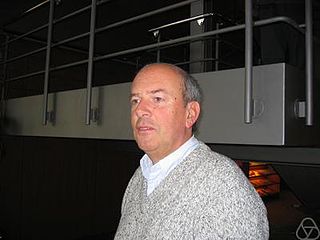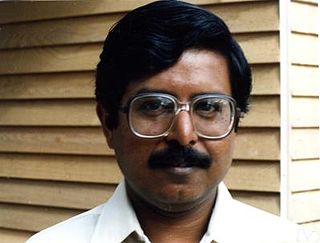Related Research Articles

Algebraic geometry is a branch of mathematics which classically studies zeros of multivariate polynomials. Modern algebraic geometry is based on the use of abstract algebraic techniques, mainly from commutative algebra, for solving geometrical problems about these sets of zeros.
In commutative algebra, a Gorenstein local ring is a commutative Noetherian local ring R with finite injective dimension as an R-module. There are many equivalent conditions, some of them listed below, often saying that a Gorenstein ring is self-dual in some sense.

Sergei Petrovich Novikov is a Soviet and Russian mathematician, noted for work in both algebraic topology and soliton theory. In 1970, he won the Fields Medal.

Michael Artin is a German-American mathematician and a professor emeritus in the Massachusetts Institute of Technology Mathematics Department, known for his contributions to algebraic geometry.

Macaulay2 is a free computer algebra system created by Daniel Grayson and Michael Stillman for computation in commutative algebra and algebraic geometry.

David Eisenbud is an American mathematician. He is a professor of mathematics at the University of California, Berkeley and former director of the then Mathematical Sciences Research Institute (MSRI), now known as Simons Laufer Mathematical Sciences Institute (SLMath). He served as Director of MSRI from 1997 to 2007, and then again from 2013 to 2022.
Combinatorial commutative algebra is a relatively new, rapidly developing mathematical discipline. As the name implies, it lies at the intersection of two more established fields, commutative algebra and combinatorics, and frequently uses methods of one to address problems arising in the other. Less obviously, polyhedral geometry plays a significant role.
In abstract algebra, a multiplicatively closed set is a subset S of a ring R such that the following two conditions hold:
In algebraic geometry, the homogeneous coordinate ringR of an algebraic variety V given as a subvariety of projective space of a given dimension N is by definition the quotient ring
In algebra, the Amitsur–Levitzki theorem states that the algebra of n × n matrices over a commutative ring satisfies a certain identity of degree 2n. It was proved by Amitsur and Levitsky (1950). In particular matrix rings are polynomial identity rings such that the smallest identity they satisfy has degree exactly 2n.
In mathematics, the Hilbert–Burch theorem describes the structure of some free resolutions of a quotient of a local or graded ring in the case that the quotient has projective dimension 2. Hilbert (1890) proved a version of this theorem for polynomial rings, and Burch (1968, p. 944) proved a more general version. Several other authors later rediscovered and published variations of this theorem. Eisenbud gives a statement and proof.

The Istituto Nazionale di Alta Matematica Francesco Severi, abbreviated as INdAM, is a government created non-profit research institution whose main purpose is to promote research in the field of mathematics and its applications and the diffusion of higher mathematical education in Italy.
Claudio Procesi is an Italian mathematician, known for works in algebra and representation theory.

Corrado de Concini is an Italian mathematician and professor at the Sapienza University of Rome. He studies algebraic geometry, quantum groups, invariant theory, and mathematical physics.
In algebraic group theory, a wonderful compactification of a variety acted on by an algebraic group is a -equivariant compactification such that the closure of each orbit is smooth. Corrado de Concini and Claudio Procesi (1983) constructed a wonderful compactification of any symmetric variety given by a quotient of an algebraic group by the subgroup fixed by some involution of over the complex numbers, sometimes called the De Concini–Procesi compactification, and Elisabetta Strickland (1987) generalized this construction to arbitrary characteristic. In particular, by writing a group itself as a symmetric homogeneous space, , this gives a wonderful compactification of the group itself.

Neithalath Mohan Kumar is an Indian mathematician who specializes in commutative algebra and algebraic geometry. Kumar is a full professor at Washington University in St. Louis.
In algebra, a graded-commutative ring is a graded ring that is commutative in the graded sense; that is, homogeneous elements x, y satisfy
In algebra, the first and second fundamental theorems of invariant theory concern the generators and the relations of the ring of invariants in the ring of polynomial functions for classical groups. The theorems are among the most important results of invariant theory.
In invariant theory, a branch of algebra, given a group G, a covariant is a G-equivariant polynomial map between linear representations V, W of G. It is a generalization of a classical convariant, which is a homogeneous polynomial map from the space of binary m-forms to the space of binary p-forms that is -equivariant.
References
- De Concini, Corrado; Eisenbud, David; Procesi, Claudio (1982), Hodge algebras, Astérisque, vol. 91, Paris: Société Mathématique de France, MR 0680936
